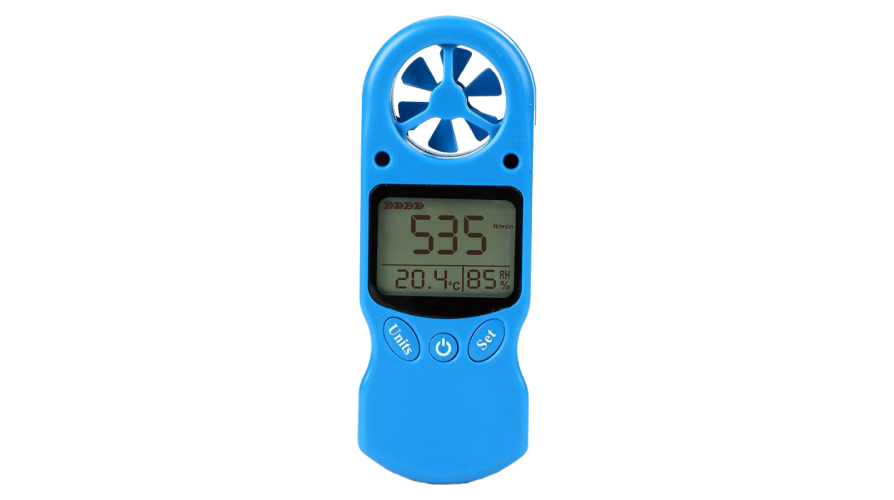Specialist Tips for Calibrating Your Anemometer for Optimum Performance
Specialist Tips for Calibrating Your Anemometer for Optimum Performance
Blog Article
All You Need to Find Out About Anemometers: How They Function, Why They Issue, and Where to Utilize Them
Anemometers, however frequently ignored in the realm of clinical tools, play a vital role in various areas, providing useful understandings right into wind rate and air movement patterns. Understanding the auto mechanics behind these devices is necessary for any individual seeking to harness the power of this data. From meteorologists tracking weather condition patterns to designers designing frameworks with wind lots in mind, the applications of anemometers are far-ranging and diverse. As we look into the ins and outs of anemometer technology, we will certainly discover the inner workings of these tools, their value, and the crucial factors to consider when picking the best anemometer for certain applications.

Anemometer Basics
A necessary tool used to determine wind rate and direction, the anemometer plays a vital duty in weather forecasting and various sectors. An anemometer usually contains 3 or four cups that revolve in the wind, a vane that points into the wind, and sensors to track the activities or rotations. By calculating the turnings or movements over a specific amount of time, the anemometer can figure out wind rate. The vane helps determine wind instructions by directing right into the wind, providing beneficial data for climate forecasting, aeronautics, maritime procedures, environmental monitoring, and wind energy applications.
There are various kinds of anemometers offered, including cup anemometers, vane anemometers, hot-wire anemometers, and sonic anemometers, each with its special functions and applications. Cup anemometers are frequently utilized for standard wind rate dimensions, while vane anemometers are favored for directional measurements. Hot-wire anemometers are appropriate for low airspeeds, and sonic anemometers are ideal for high-precision measurements in research study and commercial settings. Recognizing the basics of anemometers is essential for exact wind data collection and evaluation throughout different markets.
Concepts of Anemometer Procedure
Structure on the fundamental understanding of anemometer essentials, the concepts of anemometer operation elucidate the auto mechanics behind wind rate and direction measurements. Cup anemometers, for circumstances, have 3 or more cups that capture the wind, creating them to rotate quicker as the wind rate boosts. Hot-wire anemometers rely on a warmed cable that cools down as wind passes over it, Read Full Article with the rate of cooling figuring out the wind speed.
Significance of Anemometers
The relevance of anemometers in meteorology and different industries can not be overemphasized. Anemometers play a vital function you can try these out in gauging wind rate and direction, offering essential information for weather projecting, environment studies, ecological monitoring, and aeronautics procedures. Meteorologists depend on anemometers to collect accurate wind information, aiding them recognize weather patterns, predict storms, and concern timely cautions to the general public. In sectors such as building, farming, sustainable power, and maritime procedures, anemometers are used to enhance procedures, guarantee safety and security, and boost efficiency. Wind farm drivers use anemometers to examine wind problems and make the most of electrical energy production from wind generators. In the maritime sector, anemometers aid ship navigation by providing real-time wind info to captains, aiding them make educated choices to ensure risk-free voyages. On the whole, anemometers are essential tools that add significantly to safety, efficiency, and educated decision-making in meteorology and a broad variety of sectors.
Applications Throughout Different Industries
In the renewable energy field, anemometers play a crucial function in assessing wind problems for wind farm positionings, ensuring ideal energy manufacturing. Industries like building and mining use anemometers to keep track of wind speeds, crucial for security procedures, particularly when working at heights or in open-pit mines where strong winds can position dangers. In farming, anemometers aid farmers in managing plant spraying by offering real-time data on wind rate to stay clear of drift.

Selecting the Right Anemometer for Your Needs
For basic objectives, a mug anemometer is ideal for gauging wind rate, while a vane anemometer gives wind instructions information. Hot-wire anemometers are ideal for low airspeed measurements, and ultrasonic anemometers offer high precision and sturdiness.

Conclusion
In verdict, anemometers play a vital duty in measuring wind rate and direction throughout various markets. It is vital to consider the importance of anemometers in order to make enlightened choices when picking the most ideal device for determining wind conditions.
There are numerous kinds of anemometers offered, consisting of mug anemometers, vane anemometers, hot-wire anemometers, and sonic anemometers, each with its unique features and applications. Cup internet anemometers are frequently used for standard wind rate dimensions, while vane anemometers are preferred for directional dimensions. Hot-wire anemometers are ideal for reduced airspeeds, and sonic anemometers are suitable for high-precision dimensions in study and industrial settings.Building on the foundational understanding of anemometer essentials, the concepts of anemometer operation clarify the mechanics behind wind speed and instructions measurements. For basic functions, a cup anemometer is appropriate for gauging wind speed, while a vane anemometer supplies wind instructions data.
Report this page